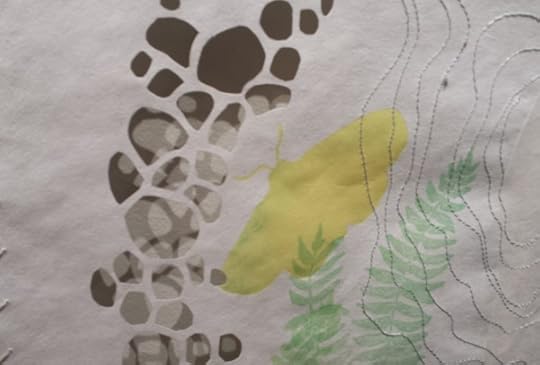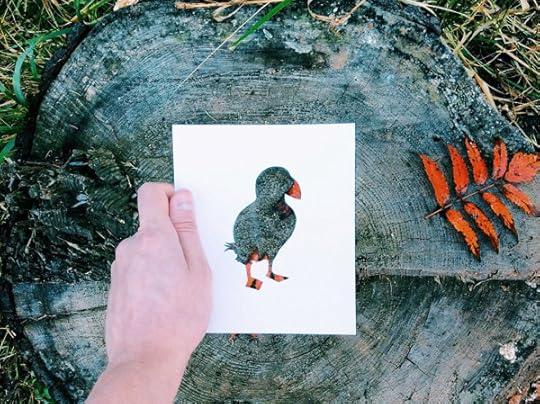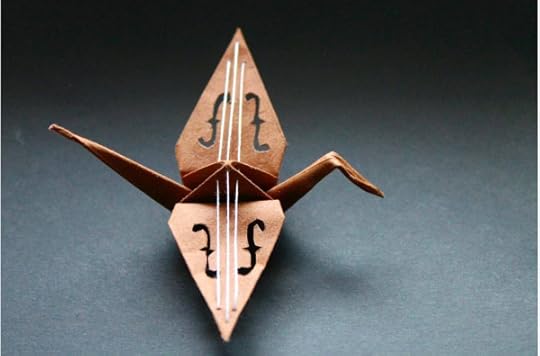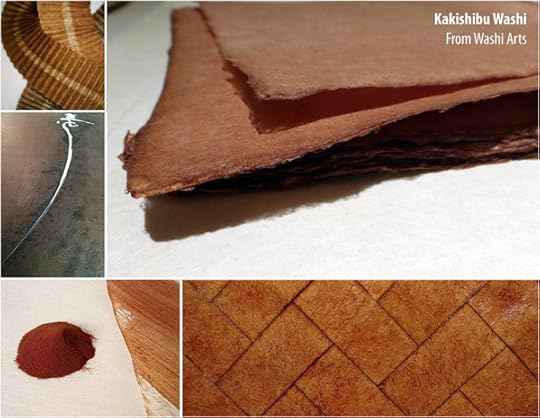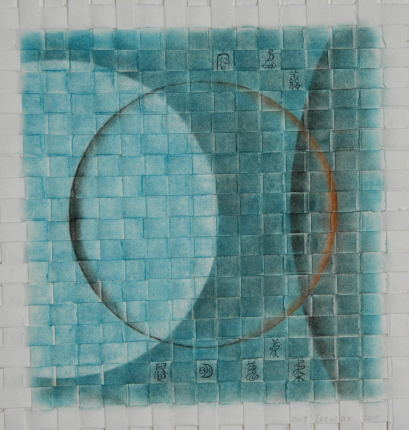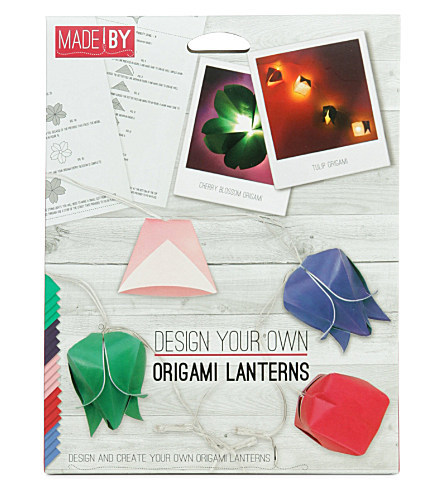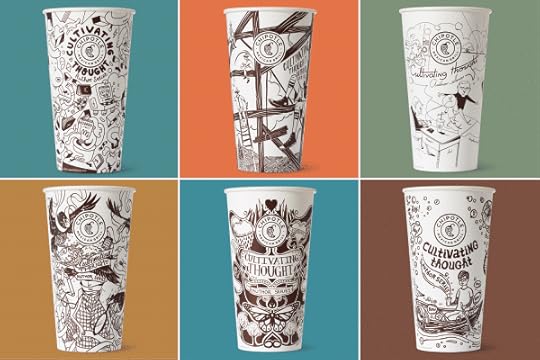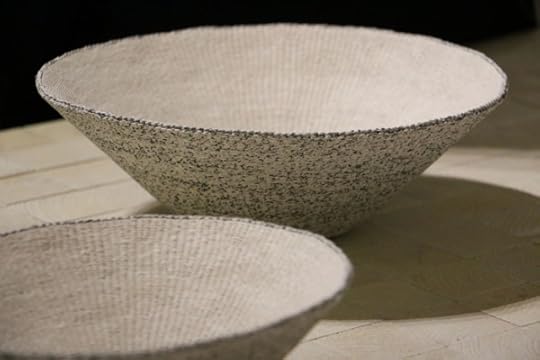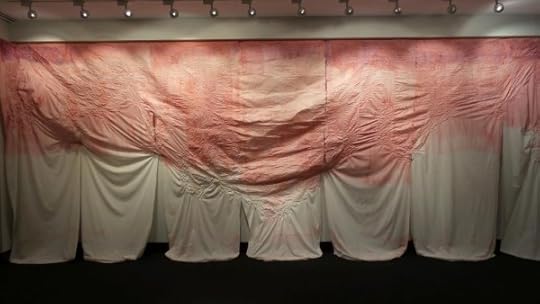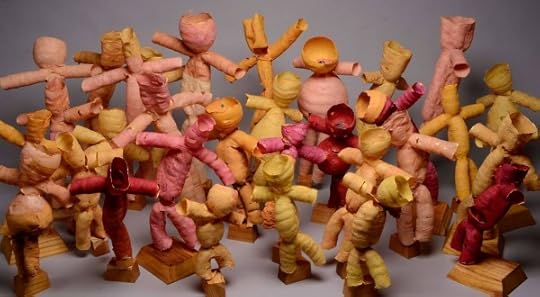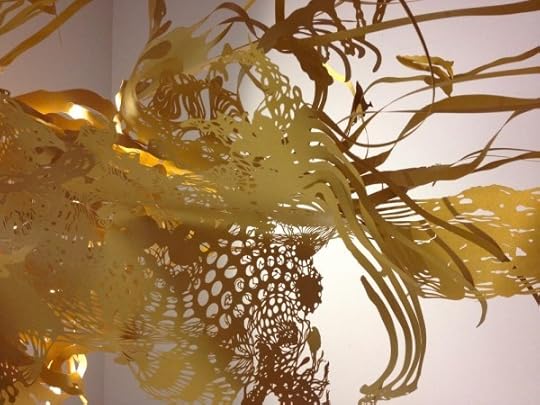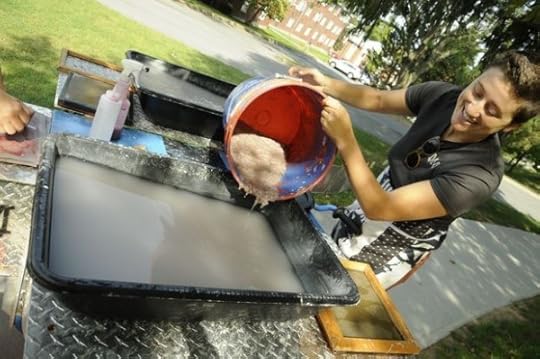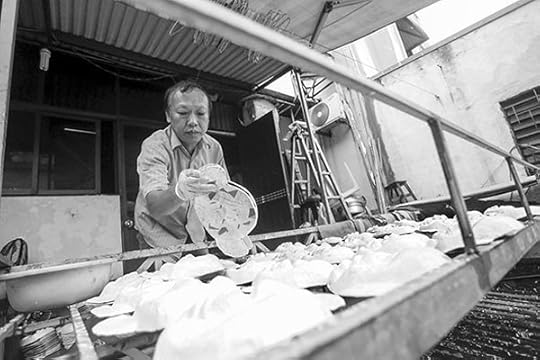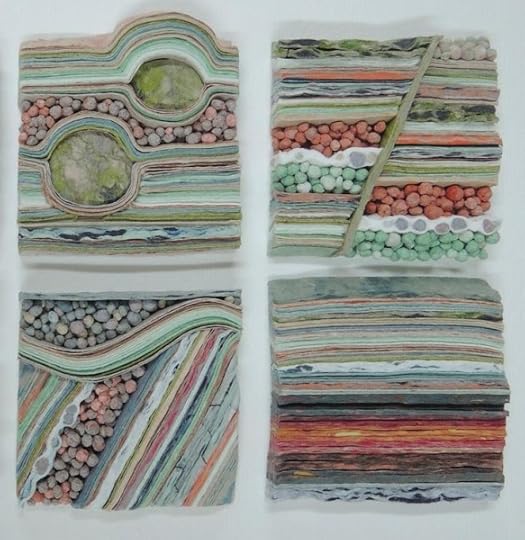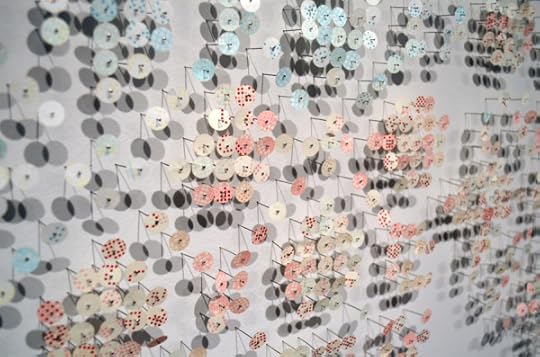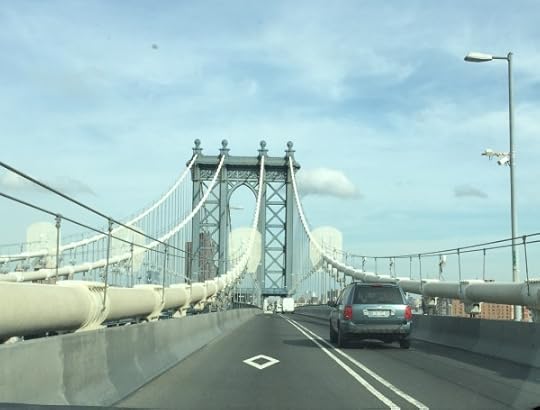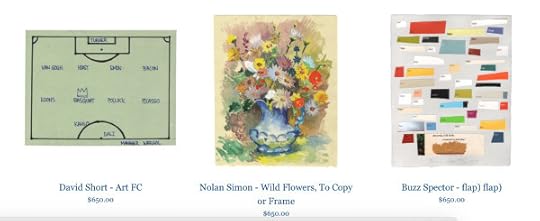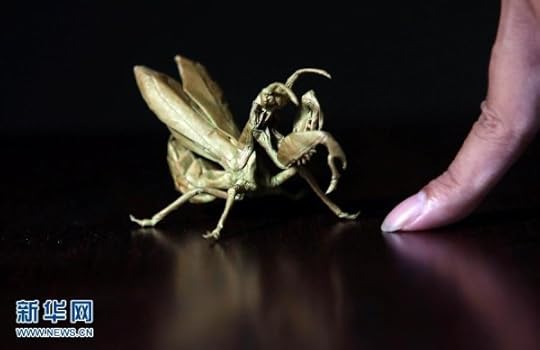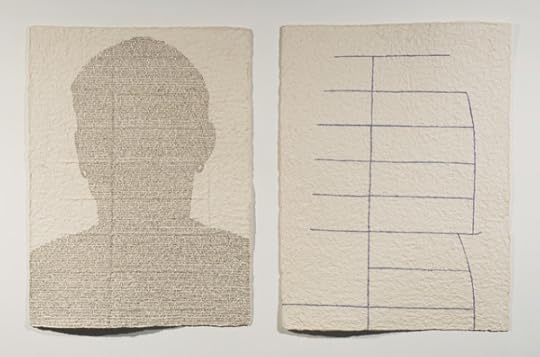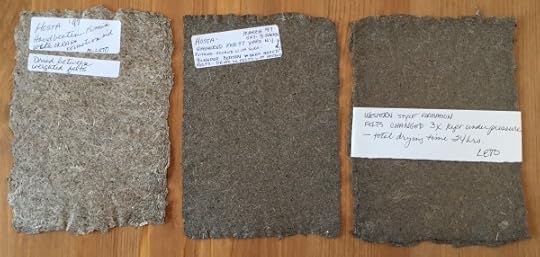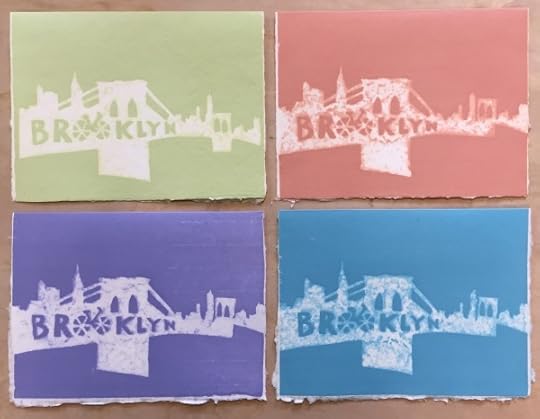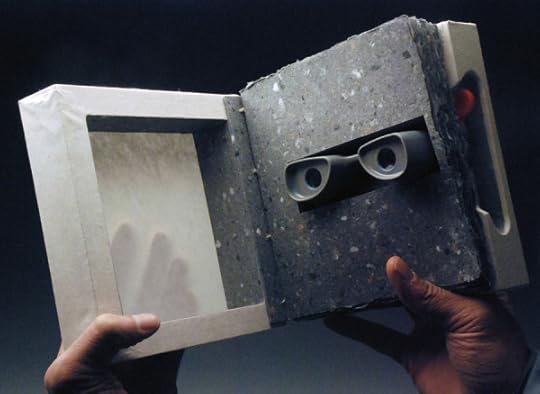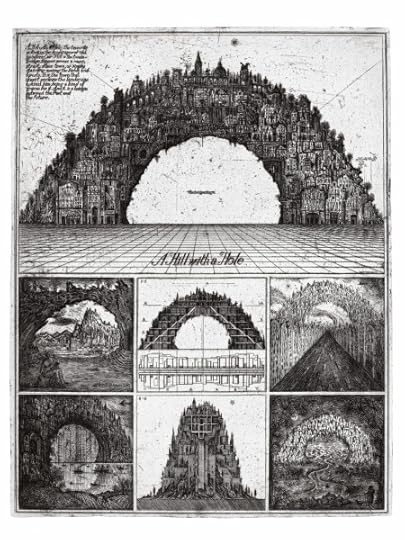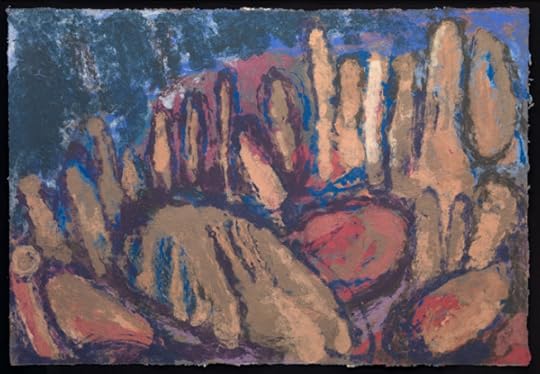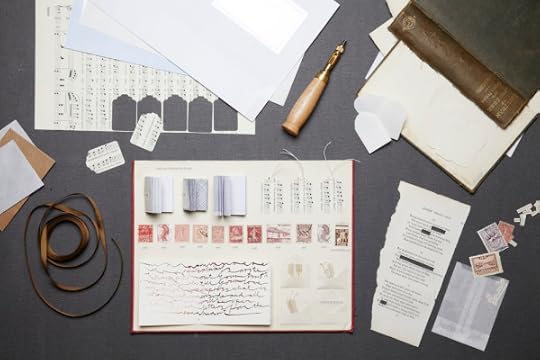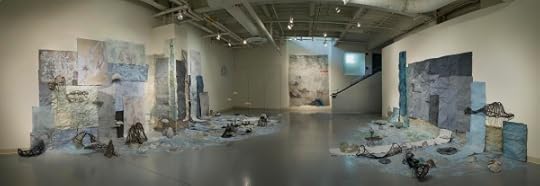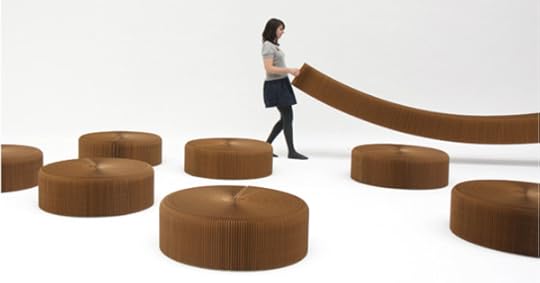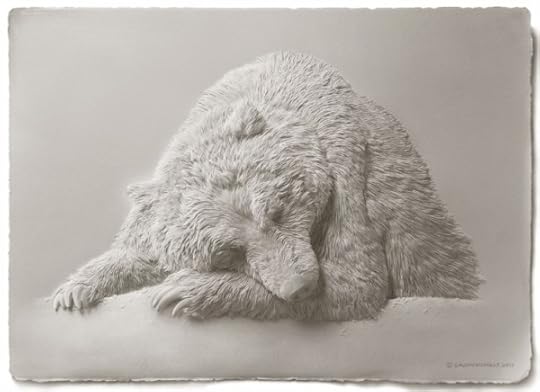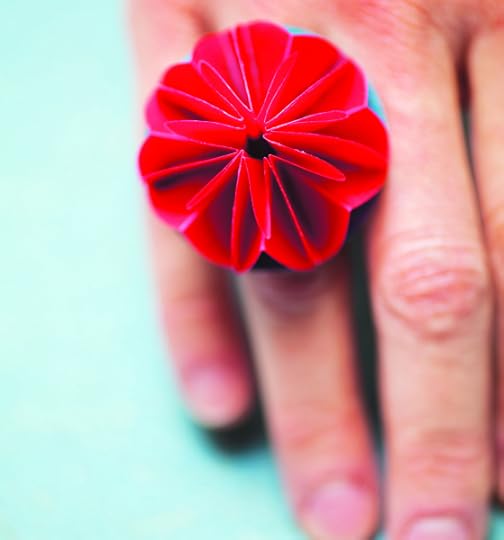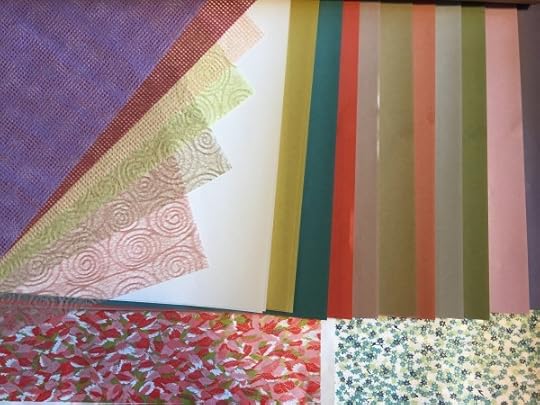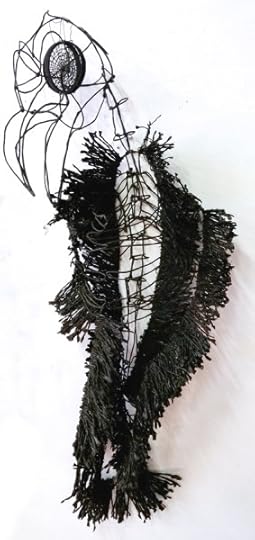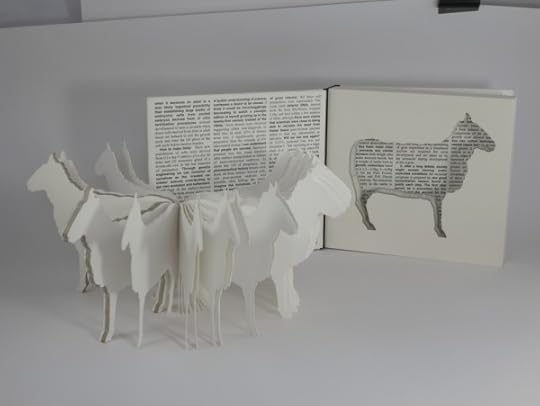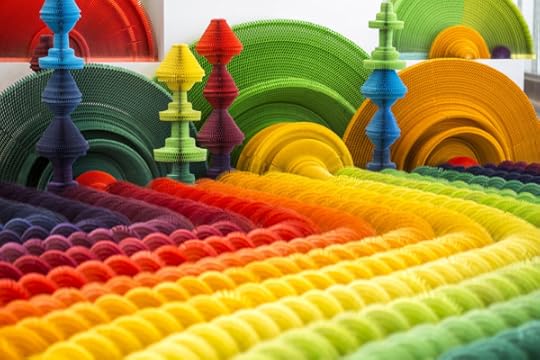Helen Hiebert's Blog, page 60
October 31, 2015
Money Paper
The Sunday Paper #79
Paper of the Week: Money Paper
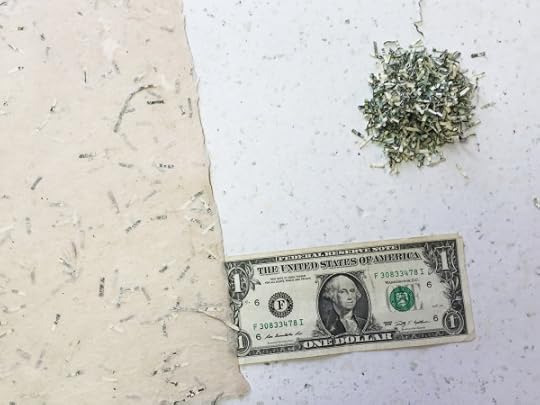
Did you know that you can buy shredded money from the Bureau of Engraving and Printing? They sell 5 pound bags of shredded U.S. currency that contain approximately $10,000 in shredded bills. I made the linen/shred mix that lies beneath the dollar bill pictured here and Jessica Spring used that paper to make her book Rags to Riches. My friend Susan made the paper on the left by mixing the shredded currency with kozo.
How have you used shredded currency?
————————————————————————————————————––––––––––––
In the Studio: Grant Writing

Speaking of money, I’ve been busy this past month writing three grant proposals. This is a tricky business, because it takes a lot of time (at least for me) to put together a proposal and grants are not guaranteed. That said, if you can convince a funder that you are worthy of their support, it is totally worth it because they provide the funds for your project. I have been fortunate over the years to receive quite a few grants (and I’ve been rejected plenty of times as well). What I’ve discovered about the process is that it helps me plan my projects. I almost always apply for funding for projects that I know I will do regardless of whether or not I receive the funding – I learned long ago that a rejection doesn’t mean you can’t do it, it just means you have to find another way. You can’t take it personally either – the grant world is competitive, and there are other people out there who are just as deserving. You’ll read about my projects in the coming months, even if I don’t receive the grants!
————————————————————————————————————––––––––––––
Sponsor of the Week: Robert C. Williams Museum of Papermaking
From September 11 to November 20, 2015, the Robert C. Williams Museum of Papermaking presents Paper Narratives, an invitational group exhibition featuring the work of five artists: Doug Baulos, Denise Bookwalter, Kerri Cushman, Lauren Faulkenberry, and Lee Emma Running. Each artist utilizes paper as a primary ingredient to manifest their ideas. This exhibition is curated by Suzanne Sawyer.
© 2015 Lauren Faulkenberry, detail of Villanelle for Mitchell County,
hand-cut handmade paper, letterpress printing, sewing, 7.5’ wide by 3.75’ tall
Lauren Faulkenberry is “a collector of words, objects, images, and obsessions. Books have always been a source of discovery for me, and have now become my way of exploring intersections: that of our fears and desires, histories and dreams, places that ground us and the people who change us…. My work reflects a preoccupation with mythology, the fragmented nature of memory, and the patterns that emerge in our personal histories and contemporary yearnings. What interests me is how our lives intertwine, and how our memories can become fragmented and then reassembled, sometimes creating more fiction than fact. Born in the South, I couldn’t help being a storyteller–when I learned printing and bookbinding, I was all in. Under the imprint of Firebrand Press, I create books, prints, and ephemera that are letterpress-printed and hand-bound.”
Lauren is the final artist to be featured in the Paper Narratives exhibit at the Paper Museum, and she beautifully explained the process of creating “Villanelle for Mitchell County” in her blog. Two of her tunnel books are also exhibited, “Touch” and “The Barred Owl.”
————————————————————————————————————––––––––––––
I know this is a day late, but it is too sweet to skip it. Happy Belated Halloween! This book, Silly Haunted House: a Not Too Spooky Halloween Book, won a 2015 Gold Moonbeam Award and was conceptualized by Yevgeniya Yeretskaya and brought to life with a sweet poem by Janet Lawler, the whimsical illustrations of Anna Chambers, and the inventive paper-engineering of Renee Jablow.
I love looking for paper in odd places. Do you see the paper in this photo? I’m sure you could come up with several types of paper in the kitchen, but do you cook with parchment paper? I use it to line baking sheets, but haven’t explored making entire meals in parchment.
Here’s a series of paper cuts that are cleverly displayed in nature. The possibilities are endless, and these images make me think about the lens that I view the world through!
Do you see what this is? Wow, you’re gonna love this series of paper cranes by Cristian Marianciuc.
This is a nice article about Peace Paper, a traveling art therapy program that incorporates the papermaking process in which art therapists and Peace Paper employees travel to college campuses to create paper from underwear and advocate for the end of domestic violence. Survivors of sexual trauma are invited to speak about their experience or simply partake in the process. The group also works with veterans of all ages to use art as a coping mechanism. They can bring in their old uniforms to create paper and write special messages on them.
————————————————————————————————————––––––––––––
About our sponsor: Wa = Japanese and shi = paper. Washi = Japanese Paper. Washi Arts sole focus is Japanese papers, tools and supplies for creative artists and businesses. By having this focus we can offer the widest range of papers – fibers, colors, patterns, weights and sizes for a variety of uses. Japan has a culture that honors excellence in craftsmanship and the 1,400 years of continuous paper-making mean the quality in excellent and dependable. Washi Arts is a retail partner of The Japanese Paper Place in Toronto, which has the largest selection of Japanese paper, under one roof, anywhere in the world. Get daily creative inspiration and see what artists, architects, designers, calligraphers, binders and conservators are doing with washi on instagram, facebook, and twitter.
————————————————————————————————————––––––––––––
About our sponsor: Did you know that we have a papermaking museum in America? It is Atlanta, and it is a fantastic place to visit! It is open to the public, and you can view exhibitions, take workshops and discover the amazing history of paper. For those of you who know who Dard Hunter was (if you don’t, look him up!) his collection is housed in the museum.
————————————————————————————————————––––––––––––
 If you enjoyed reading The Sunday Paper today, why not sign up to get it delivered to your in-box each and every Sunday? Click here to subscribe (it’s free), and you’ll receive my nifty pop-up alphabet template as a thank you gift!
If you enjoyed reading The Sunday Paper today, why not sign up to get it delivered to your in-box each and every Sunday? Click here to subscribe (it’s free), and you’ll receive my nifty pop-up alphabet template as a thank you gift!
If you read this blog regularly, would you consider making a donation to support the research, writing, design and delivery of The Sunday Paper? Click on that cute paper button (I made that paper) to see how you can provide support.
And if you run a paper-related business, you might be interested in promoting your business in The Sunday Paper.
Thank you to those who have pledged your support, and enjoy your Sunday!
October 24, 2015
Kakishibu
The Sunday Paper #78
Sponsored Paper of the Week: Oguni Shikishi – Kakishibu – Persimmon Treated Kozo Washi Paper from Washi Arts
Images from left to right
Kakishibu pleated and pattern dyed washi / Kakishibu dyed Oguni Shikishi handmade Japanese kozo washi paper 7.5” x 7.5” / Antique Japanese stencil of kakishibu treated washi which has been oiled, smoked and aged / kakishibu powder and a stroke of kakishibu dye / kakishibu treated washi · woven (image from Kakishibuii)
This Kakishibu dyed 65g kozo washi Japanese paper is 7.5″ x 7.5″ and is handmade with four deckle edges and is sized. This is a wonderful sheet for small works.
Oguni is the Japanese village where the paper is made. Shikishi refers to the small square format traditionally used for calligraphy and small drawings. Kakishibu (kaki = persimmon, shibu = tannin) is fermented persimmon juice which has been aged for more than five years to extract maximum tanins which give the juice/dye waterproofing and strengthening qualities as well as a beautiful color which continues to deepen and develop over several years. These handmade kozo washi squares have been treated with multiple layers of the kakishibu ready for you to use for stencils, embellished pages for books, printmaking, collage and structures.
You can also order natural kozo squares and kakishibu powder to treat and dye your own paper. Note that the short fibers of Western paper make it unsuitable for kakishibu as it is too weak when wet.
Washi Arts is offering this special to Sunday Paper readers: Three sheets of handmade kozo washi scroll format paper 6.75” x 21.75” (shipped folded) with a sampler of kakishibu powder and instructions for using. Regular value is $32.00 / Special price is $25.00
————————————————————————————————————––––––––––––
In the Studio:
Today’s studio update is about another studio – the Mills College Book Arts studio and program. Please join our efforts to save the only MFA in Book Art & Creative Writing in the country – an innovative, interdisciplinary program with an international reputation.
Here’s how you can help (please click now, this is urgent): Sign the petition.
Share you story about the program on Tumblr.
Thanks for your support of this vital and active book arts program that is churning out professionals in our field! I do believe that together we can make a difference.
————————————————————————————————————––––––––––––
If you are thinking of attending the 2020 olympics in Tokyo, you’ll be delighted to learn that a total of 10 companies in Japan have put their combined energies into the creation of this new automated paper cutting and folding machine. Called the Orifuji, the concept initially came about as a way to express the Japanese culture of omotenashi, or hospitality, in restrooms ahead of the 2020 Tokyo Olympics.
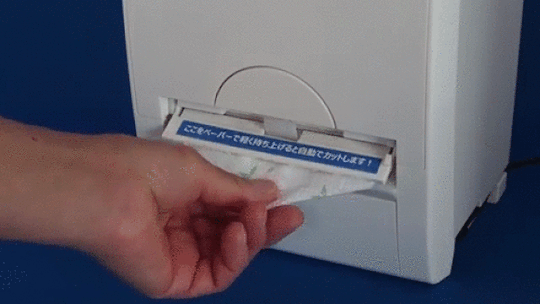
I love these paper weavings by Amy Loewan at the Willock and Sax Gallery in Banff, Canada. These are on view now during the annual meeting of the Friends of Dard Hunter, which is just wrapping up in Banff.
You probably know that I have an obsession with paper and light. Check out these sweet little origami lanterns that can simply slip onto those holiday light strands.
Here’s a twist on the reusable paper cup from Chipotle. The marketing team decided to partner with well known writers to enlighten us while we drink (and eat – they’ve created unique paper bags too) through their Cultivating Thought initiative. And yes, this is slightly old news (maybe you’ve already seen these) because this editor cooks food at home rather than frequenting fast food chains.
There are so many paper resource on-line these days. Here’s a link to the Decorated and Decorative Paper Collection at the University of Washington.
————————————————————————————————————––––––––––––
About our sponsor: Wa = Japanese and shi = paper. Washi = Japanese Paper. Washi Arts sole focus is Japanese papers, tools and supplies for creative artists and businesses. By having this focus we can offer the widest range of papers – fibers, colors, patterns, weights and sizes for a variety of uses. Japan has a culture that honors excellence in craftsmanship and the 1,400 years of continuous paper-making mean the quality in excellent and dependable. Washi Arts is a retail partner of The Japanese Paper Place in Toronto, which has the largest selection of Japanese paper, under one roof, anywhere in the world. Get daily creative inspiration and see what artists, architects, designers, calligraphers, binders and conservators are doing with washi on instagram, facebook, and twitter.
————————————————————————————————————––––––––––––
 If you enjoyed reading The Sunday Paper today, why not sign up to get it delivered to your in-box each and every Sunday? Click here to subscribe (it’s free), and you’ll receive my nifty pop-up alphabet template as a thank you gift!
If you enjoyed reading The Sunday Paper today, why not sign up to get it delivered to your in-box each and every Sunday? Click here to subscribe (it’s free), and you’ll receive my nifty pop-up alphabet template as a thank you gift!
If you read this blog regularly, would you consider making a donation to support the research, writing, design and delivery of The Sunday Paper? Click on that cute paper button (I made that paper) to see how you can provide support.
And if you run a paper-related business, you might be interested in promoting your business in The Sunday Paper.
Thank you to those who have pledged your support, and enjoy your Sunday!
October 17, 2015
Paper String
The Sunday Paper #77
Paper of the Week: Korean Paper String
Ooh la la. This is a lovely video showing two Korean artisans, Kang Seong-hi and Kim Eun-hye twisting paper string and then weaving it into vessel forms.
Bowls to Hold Mind are containers made of two twisted threads of mulberry paper (hanji) strips by Kim Eun-hye.
————————————————————————————————————––––––––––––
Sponsor of the Week: Robert C. Williams Museum of Papermaking
From September 11 to November 20, 2015, the Robert C. Williams Museum of Papermaking presents Paper Narratives, an invitational group exhibition featuring the work of five artists: Doug Baulos, Denise Bookwalter, Kerri Cushman, Lauren Faulkenberry, and Lee Emma Running. Each artist utilizes paper as a primary ingredient to manifest their ideas. This exhibition is curated by Suzanne Sawyer. We’ll be highlighting each of the other artists in future issues of The Sunday Paper.
© Lee Emma Running 2015, Watercourse, Muslin, Cochineal, Abaca, approximately 24′ x 12′
Artist Lee Emma Running is an associate professor at Grinnell College and uses her work to investigate the beauty and complexity of natural phenomena. Running says “I fell in love with handmade paper for it’s humility, it’s process, and it’s chameleon nature. The same fiber with different treatment can behave like fabric or leather, silk or fiberglass. Handmade paper opened a way of thinking for me as an artist. My training is as a papermaker and sculptor, and now I make drawings and site-specific installations. Papermaking taught me to innovate, and to pay close attention with all of my senses. This installation is an exploration of natural dye and handmade paper, two materials for which water is primary.”
The installation base is muslin fabric hand-dyed with cochineal, an ancient dye made from insects. The color ranges from orange to purple, depending on the pH of the dye and material it is used on. When the dye is re-wet, it becomes fugitive and runs. Individual 8 x 8 sheets of stenciled abaca were couched over the muslin. As the abaca dries it contracts, pulling and puckering the fabric beneath. The paper is strong enough to give form to the fabric, and to bridge gaps between fabric panels.
Watercourse was made on site over a five-day period in August at the Paper Museum. Students, volunteers, and museum staff worked to support Lee in this exciting project. This time-lapse photo video shows the installation in only three minutes.
————————————————————————————————————––––––––––––
In the Studio: Last November, I visited Lincoln, Nebraska where I lectured at the University, taught a workshop at Constellation Studios and began a collaboration with Karen Kunc. I’m aiming to finish my part of the collaboration before a year is up! I’ve got my 12″ x 18″ Tim Moore mould set up with the watermark image for our 8-page artists’ book. After I make the paper, Karen will design her imagery and print. Stay tuned for the results!
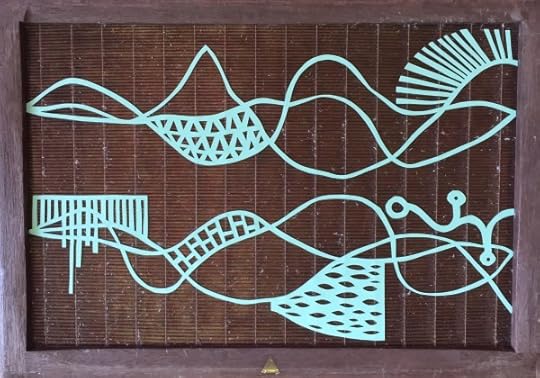
————————————————————————————————————––––––––––––
I met paper engineer Becca Zerkin in Philadelphia last year at the annual meeting of the Movable Book Society. She’s doing some amazing educational programs with pop-ups. Check out the trailer for her new book, The Walking Dead, The Pop-Up Book which is not quite as gruesome as the actual show…
Paper has always been used in clever ways in advertising. Watch how Swedish landscapes came to life through paper for a Do Something cover wrap.
If you are in the Chicago area, check out these charming Sentinels by Laurie LeBreton. “Flights of Fancy: Unexpected Works of Whimsy”, at the Northbrook Public Library, 1201 Cedar Lane, Northbrook, IL.
The North Dakota Museum of Art is currently showing sculptural paper cuts by artist Fred Liang through December 13th. Love the shadows!
These fact-filled origami boats posted around U.K. cities and towns are spreading a larger message about Europe’s refugee crisis. Artist Bern O’Donoghue created the art project Refugees Crossing as a way to inform people about the challenges facing refugees and migrants.
————————————————————————————————————––––––––––––
About our sponsor: Did you know that we have a papermaking museum in America? It is Atlanta, and it is a fantastic place to visit! It is open to the public, and you can view exhibitions, take workshops and discover the amazing history of paper. For those of you who know who Dard Hunter was (if you don’t, look him up!) his collection is housed in the museum.
————————————————————————————————————––––––––––––
 If you enjoyed reading The Sunday Paper today, why not sign up to get it delivered to your in-box each and every Sunday? Click here to subscribe (it’s free), and you’ll receive my nifty pop-up alphabet template as a thank you gift!
If you enjoyed reading The Sunday Paper today, why not sign up to get it delivered to your in-box each and every Sunday? Click here to subscribe (it’s free), and you’ll receive my nifty pop-up alphabet template as a thank you gift!
If you read this blog regularly, would you consider making a donation to support the research, writing, design and delivery of The Sunday Paper? Click on that cute paper button (I made that paper) to see how you can provide support.
And if you run a paper-related business, you might be interested in promoting your business in The Sunday Paper.
Thank you to those who have pledged your support, and enjoy your Sunday!
October 10, 2015
Cardboard Cars
The Sunday Paper #76
Featured Paper of the Week: Pour Papers from Arnold Grummer’s® Papermaking
Women In Retreat: Recently, sixty women from all over the country descended on Neenah, WI – in the heart of the Paper Valley – to experience the best the local community and small businesses have to offer. Tricia Morris and her team at Club Scrap put on an annual gala incorporating specialty papers from around the area and world. Workshops included materials and techniques to create cards, scrapbook pages and books.
This year, participants made handmade papers in a two-hour session using Arnold Grummer’s pour handmolds, an ideal system for out-of-studio classes, even in a fancy hotel. The next day, participants turned their papers into book covers. The white leaves in this photo were rubber stamped with white ink. The saying was printed on white card stock, torn using a water brush and ruler and layered onto the handmade paper before mounting on the assembled journal. Each participant created a ‘Fold ‘N’ Hold’ Journal like the one shown here. No glue, no stitches.
Arnold Grummer’s extends the retreat discount to Sunday Paper readers. Use Code SP10 and receive a 10% discount on any order through 10/18.
————————————————————————————————————––––––––––––
In the Studio: I’m working on a new artist’s book for an exhibition at the University of Washington next year. I was given a prompt to respond to a text, and I’m looking for short vignettes if you’d like to contribute: I need misconceptions or falsehoods about issues related to abortion, adoption, and marriage. Here’s an example… a friend of mine was told by her boyfriend that “you can’t get pregnant the first time you have sex” (and you can guess what happened).
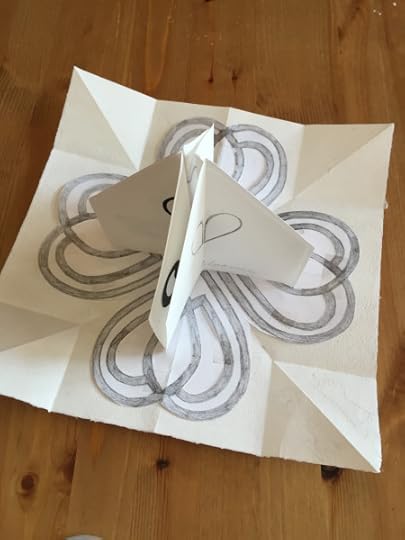
————————————————————————————————————––––––––––––
Check out the new cardboard Lexus. The idea behind this car was to celebrate “the human craftsmanship skills that go into every car” Lexus makes. Cool! Take a peek at these photos that show the inner workings of the car.
Papermaking on the move! The Mobile Mill has been making appearances across the Northeast. Here’s a great summary of artist Jillian Bruschera’s recent visit to Wells College and the way that she is connecting communities with papermaking.
It makes me sad to read this headline: “The last paper maché mask makers in Hanoi”. But it sounds like there are museums interested in keeping the craft alive. I hope it’s true!
Artist Lucy Baxandall is interested in the stages of hand papermaking – from fibre gathering and preparation through to drying – it is a meditative process during which she thinks about the work that will later be done with, or on, the paper, which often draws on geological forces as the vegetable becomes a mineral.
I wrote about Paperworks at the LA Craft & Folk Art Museum a few weeks ago. Here’s a review that appeared in the Los Angeles Times.
————————————————————————————————————––––––––––––
 If you enjoyed reading The Sunday Paper today, why not sign up to get it delivered to your in-box each and every Sunday? Click here to subscribe (it’s free), and you’ll receive my nifty pop-up alphabet template as a thank you gift!
If you enjoyed reading The Sunday Paper today, why not sign up to get it delivered to your in-box each and every Sunday? Click here to subscribe (it’s free), and you’ll receive my nifty pop-up alphabet template as a thank you gift!
If you read this blog regularly, would you consider making a donation to support the research, writing, design and delivery of The Sunday Paper? Click on that cute paper button (I made that paper) to see how you can provide support.
And if you run a paper-related business, you might be interested in promoting your business in The Sunday Paper.
Thank you to those who have pledged your support, and enjoy your Sunday!
October 3, 2015
Support Handmade Paper!
The Sunday Paper #75
Paper of the Week: Shaped Paper
Making shaped papers is a unique hand papermaking technique. There really isn’t any other way to get a shaped sheet of paper with deckled edges. For those of us who make paper, it is a simple way to create envelopes, hearts, circles or multiple shapes on a large deckle.
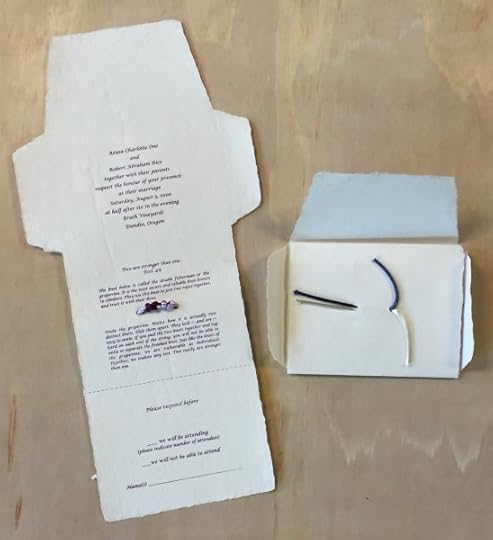
I designed this shaped deckle for my wedding invitation many moons ago. I was delighted when I figured out how to incorporate the invitation, envelope and response postcard all in one sheet of paper. In case you are reading the fine print, this is a picture of someone else’s wedding invitation – the design was popular (and economical) so it was reproduced and sold by Oblation Papers & Press for a few years.
I used to cut my shaped deckles in Artcor (similar to foam core, but made entirely of plastic, i.e. waterproof) but it is hard to find these days. I’ve resorted to using foam core and covering it with wide plastic tape to make it waterproof. You can also use 1/4″ styrofoam (sold in sheets at large hardware stores) or if you have a jigsaw, you can create shaped deckles from a thin wood, like masonite (if you use wood, I would recommend coating it with polyurethane). There are several ideas for making shaped papers in chapter 10 of my book The Papermaker’s Companion.
How do you make shaped papers?
————————————————————————————————————––––––––––––
Sponsor of the Week
From September 11 to November 20, 2015, the Robert C. Williams Museum of Papermaking presents Paper Narratives, an invitational group exhibition featuring the work of five artists: Doug Baulos, Denise Bookwalter, Kerri Cushman, Lauren Faulkenberry, and Lee Emma Running. Each artist utilizes paper as a primary ingredient to manifest their ideas. This exhibition is curated by Suzanne Sawyer. We’ll be highlighting each of the other artists in future issues of The Sunday Paper.
© 2015, Denise Bookwalter, Catching Floats in Fair Isle Knitting, screen print on laser cut paper with pins, approx 2 ½ feet x 12 feet x 1 inch
Denise Bookwalter’s work is the result of her perpetual pursuit of knowledge and understanding. As a child she realized quickly that the accumulation of information far exceeded the quantity that a dedicated classroom teacher had patience or time enough to teach. Initially, she approaches her work as a scientist approaches their research. “I first gather information from primary sources. As the search for images develops, I follow a considerably less linear path and am attracted by the unexpected and overlooked… The combination of research, information and play is the subject of my work.”
————————————————————————————————————––––––––––––
In the Studio:
I’ve been out of the studio for the past week, enjoying a burst of New York City! I made a little slide show about my trip, which you can view here.
————————————————————————————————————––––––––––––
Speaking of NYC, Dieu Donné Papermill’s benefit auction is coming up. If you don’t live in NYC and can’t make it to the event, they are making it easy to purchase art on-line. Check it out! Grab your favorite piece now and support this organization that has been instrumental in pushing hand papermaking into the 21st Century.
This is a pretty cool video of a paper robot. I like the animation style that shows both the construction of the robot and then how it walks.
Maybe paper engineering will become a field of study one day soon. I love the plethora of articles that feature technological developments that begin in paper. I don’t think this is anything new really, but it is certainly in the news more.
A cut or tear in a material is typically a sign of weakness. Now, a Northwestern University, University of Illinois and Tsinghua University research team has created complex 3-D micro- and nanostructures out of silicon and other materials found in advanced technologies using a new assembly method that uses cuts to advantage. The Kirigami method builds on the team’s “pop-up” fabrication technique — going from a 2-D material to 3-D in an instant, like a pop-up children’s book. While an innovative first step, those earlier ribbon-like structures yielded open networks, with limited ability to achieve closed-form shapes or to support spatially extended devices.
I’m not a bug lover, but these paper bugs by Qin Kun are pretty incredible.
This is a beautiful video on the making of Japanese handmade paper of Kyoto Kurotani.
————————————————————————————————————––––––––––––
About our sponsor: Did you know that we have a papermaking museum in America? It is Atlanta, and it is a fantastic place to visit! It is open to the public, and you can view exhibitions, take workshops and discover the amazing history of paper. For those of you who know who Dard Hunter was (if you don’t, look him up!) his collection is housed in the museum.
————————————————————————————————————––––––––––––
 If you enjoyed reading The Sunday Paper today, why not sign up to get it delivered to your in-box each and every Sunday? Click here to subscribe (it’s free), and you’ll receive my nifty pop-up alphabet template as a thank you gift!
If you enjoyed reading The Sunday Paper today, why not sign up to get it delivered to your in-box each and every Sunday? Click here to subscribe (it’s free), and you’ll receive my nifty pop-up alphabet template as a thank you gift!
If you read this blog regularly, would you consider making a donation to support the research, writing, design and delivery of The Sunday Paper? Click on that cute paper button (I made that paper) to see how you can provide support.
And if you run a paper-related business, you might be interested in promoting your business in The Sunday Paper.
Thank you to those who have pledged your support, and enjoy your Sunday!
September 26, 2015
Pleat Pleat Pleat!
The Sunday Paper #74
Paper of the Week: Pleated Abaca
I learned about manipulating wet paper from Jocelyn Chateauvert, who is the queen of this technique in my book (see her work below).
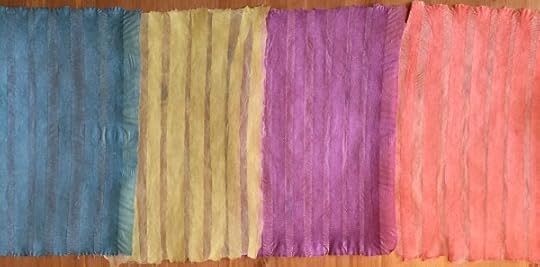
After you make and couch a sheet of paper, it is still quite fragile. But once you press it, it handles like a giant cooked pasta noodle. In other words, you can fold it, cut it, squeeze it, tear it, twist it – I think you get the idea. The sheets above are pleated – doubled back upon themselves and secured it in place with a second pressing (or brayering). Wet paper sticks to itself, no stitching necessary!
————————————————————————————————————––––––––––––
In the Studio:
I’m delighted that my newest artists’ book, 50 Revolutions, is finally ready to go into production. There are always so many details to work out during the design phase of a project! Thankfully, I love the challenge of getting what is in the mind out into the world.
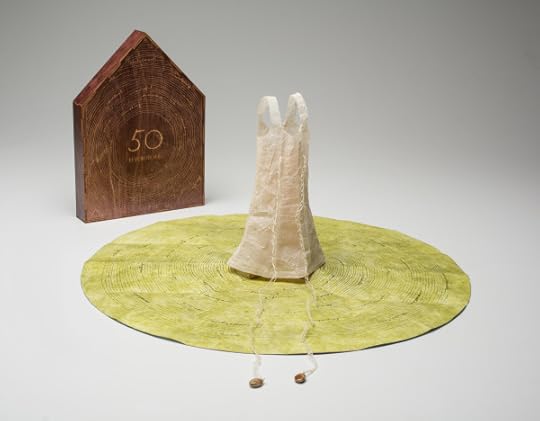
© Joecelyn Chateauvert, 2015, Opening, artist-made abaca paper, pigment, 5″h x 13″w x 9″d
Check out the clever paper (and hand) animation in this new Honda ad.
I love reading about paper exhibitions and discovering new artists. I hadn’t heard of most of the artists featured in the current exhibition at LA’s Craft and Folk Art Museum (September 27 through January 3).
Susan Sironi, In Our Image, 2014, Courtesy of Offramp Gallery, Pasadena
I was delighted to discover the work of Ben Durham recently. For this series, Durham pulled photos of his old classmates from an online database, then transformed those shots into large-scale, realistic drawings composed entirely of words associated with his memories of his subjects. The drawings are on sculptural artist-made paper.
© Ben Durham, David (Menifee Ave / Owsley Ave), 2010
Graphite and pulp painting on handmade paper, 38 × 60 in
I wrote about the Paper Pattern Story a few weeks ago. Here’s a video about the project by Bhavna Mehta, who collected patterns and stories form the community as inspiration for a cut paper installation, titled “GUSH”, at the Oceanside Museum of Art.
————————————————————————————————————––––––––––––
 If you enjoyed reading The Sunday Paper today, why not sign up to get it delivered to your in-box each and every Sunday? Click here to subscribe (it’s free), and you’ll receive my nifty pop-up alphabet template as a thank you gift!
If you enjoyed reading The Sunday Paper today, why not sign up to get it delivered to your in-box each and every Sunday? Click here to subscribe (it’s free), and you’ll receive my nifty pop-up alphabet template as a thank you gift!
If you read this blog regularly, would you consider making a donation to support the research, writing, design and delivery of The Sunday Paper? Click on that cute paper button (I made that paper) to see how you can provide support.
And if you run a paper-related business, you might be interested in promoting your business in The Sunday Paper.
Thank you to those who have pledged your support, and enjoy your Sunday!
September 19, 2015
Papermaking with Garden Plants & Common Weeds
The Sunday Paper #73
Paper of the Week: Hosta Paper
In about 1996, when I was working at Dieu Donné Papermill in NYC, I received a letter via snail mail from an editor at Storey Books, inquiring whether I would be interested in writing a book about making paper with plants. It turns out that she’d seen my Compost Papermaking workshop listed in the NY Horticultural Society’s newsletter and thought it would be an interesting book topic. A few years later my book Papermaking With Plants (now Papermaking with Garden Plants and Common Weeds) became a reality.
Hosta Paper by Mary Leto, the recipe is in my book Papermaking With Garden Weeds and Common Plants
How cool is that? I never dreamt I’d be an author, and the opportunity to put this book together forced me to lean on the generosity of my colleagues and other papermakers. One thing I decided to do when preparing the manuscript was to collect paper samples and recipes from other papermakers. The book contains 10 plant paper recipes, one in each category of plant fiber (bast, leaf, grass, etc.) Here’s a photo of the actual paper that Mary Leto submitted for making paper from her garden hosta plants, and the recipe is in my book!
In the Studio:
I’ve had the absolute pleasure of having an assistant in the studio for the past few months. Many thanks to Sandie Brayman for helping me get so much more done that I would have otherwise (and for the great company)! Sandie had no fear when I asked her to take short videos of the papermaking process. Neither she nor I are pros at this, but I think the short clips we shot get the message across. This week we were making pulp prints of the Brooklyn Bridge (available for purchase here). I love how each one is unique: can you see how crisp the image is on the green one, yet the other colors have more pulp on the image?
Here’s the short video Sandie took to show you a bit of the process.
————————————————————————————————————––––––––––––
Sponsor of the Week
From September 11 to November 20, 2015, the Robert C. Williams Museum of Papermaking presents Paper Narratives, an invitational group exhibition featuring the work of five artists: Doug Baulos, Denise Bookwalter, Kerri Cushman, Lauren Faulkenberry, and Lee Emma Running. Each artist utilizes paper as a primary ingredient to manifest their ideas. This exhibition is curated by Suzanne Sawyer. We’ll be highlighting each of the other artists in future issues of The Sunday Paper.
© 2013 Kerri Cushman, StreetView: handmade abaca & recycled clothing paper, slide film, ViewMaster reel, wood, 7 1/8″ x 7 1/8″ x 3 3/4″ (closed), 14 1/2″ x 7 1/8″ x 3 1/2″ (open)
Kerri Cushman is a sculptural book artist and avid papermaker with an affinity for letterpress. She obtained an MFA in Interdisciplinary Book & Paper Arts from Columbia College, Chicago (2004). Currently, she is an assistant professor who teaches papermaking, bookbinding, and letterpress printing at Longwood University in Virginia. Her narratives push the boundaries of what defines a book.
Cushman says, ” ‘StreetView’ is a hybrid object: part book, part ViewMaster viewer. The book’s blank facade and chunky structure reference industrial building forms. On its own, a single building block is somewhat useless, but when combined with other building materials they create the architecture of a city street—buildings, cafes, and book shops.”
————————————————————————————————————––––––––––––
Check this out: Japanese kirigami (the art of cutting and folding paper) is being used to make solar panels more efficient. Cuts in a flexible backing for solar cells allow a flat solar panel to separate into many small cells that can track the sun across the sky, which provides a 20 to 40 percent improvement in the amount of energy captured by the cells.
This headline caught my attention this week: The Most Fantastic Architecture of the Soviet Union Was Built on Paper. Restricted by the aesthetic limits on architecture in the former Soviet Union, Alexander Brodsky and Ilya Utkin imagined the most fantastic cities and wondrous structures on paper. From 1978 until the end of their partnership in 1993, Brodsky and Utkin collaborated on etchings like these, which are featured in the third edition of Brodsky & Utkin, from Princeton Architectural Press.
Alexander Brodsky and Ilya Utkin, “Hill with a Hole” (1987/90) (courtesy of Ronald Feldman Fine Arts Inc)
Maryland artist Lynn Sures is currently showing at Central Booking in Manhattan. I hope to get there next week! She’s exhibiting pulp paintings and a chine collé etching. These new works were created during residencies near Barcelona in Capellades, Spain and in Fabriano, Italy.
Lynn Sures, Montserrat 4, 2015. Pigmented abaca pulp painting, 47 x 69 inches
I dig these mythical cut paper collages by Morgana Wallace that appeared on This is Colossal.
This is kind of a cool concept (sticker art by Chasing Paper) although I’m not sure what I think about reproducing art this way.
————————————————————————————————————––––––––––––
Did you know that we have a papermaking museum in America? It is Atlanta, and it is a fantastic place to visit! It is open to the public, and you can view exhibitions, take workshops and discover the amazing history of paper. For those of you who know who Dard Hunter was (if you don’t, look him up!) his collection is housed in the museum.
————————————————————————————————————––––––––––––
 If you enjoyed reading The Sunday Paper today, why not sign up to get it delivered to your in-box each and every Sunday? Click here to subscribe (it’s free), and you’ll receive my nifty pop-up alphabet template as a thank you gift!
If you enjoyed reading The Sunday Paper today, why not sign up to get it delivered to your in-box each and every Sunday? Click here to subscribe (it’s free), and you’ll receive my nifty pop-up alphabet template as a thank you gift!
If you read this blog regularly, would you consider making a donation to support the research, writing, design and delivery of The Sunday Paper? Click on that cute paper button (I made that paper) to see how you can provide support.
And if you run a paper-related business, you might be interested in promoting your business in The Sunday Paper.
Thank you to those who have pledged your support, and enjoy your Sunday!
September 12, 2015
Discover PaperLove
The Sunday Paper #72
Paper of the Week: Graph Paper
There are a lot of mundane papers that are pretty cool, like graph paper. I thought I’d do a little research about it, and it turns out that rectangular grid paper (used for scientific notation) was first offered for sale by a Dr. Buxton in London in 1794. I never realized there were so many kinds of graph paper: polar coordinate graph paper, isometric graph paper, hexagonal graph paper, and the standard quad graph paper, to name a few. And there are even websites where you can print your own graph paper, like this one.
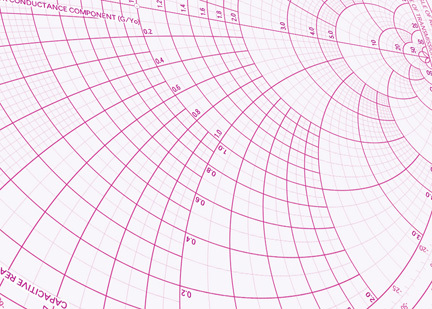
The Smith chart is a type of graph paper designed for electrical and electronics engineers.
————————————————————————————————————––––––––––––
In the Studio:
Watermarks are still on my mind, and I’m mixing them with shoji screens at this weekend’s retreat. Here you see two moulds with watermark patterns adhered to them. The paper made on those screens will be adhered to the mini shoji panels that are sitting there on the moulds. Stay tuned for photos of the actual papered screens!
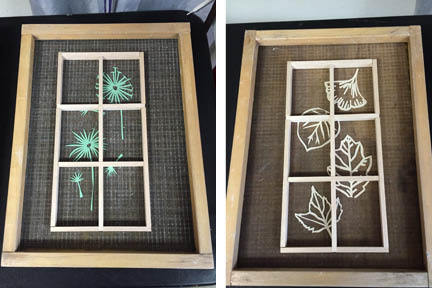
————————————————————————————————————––––––––––––
Sponsor of the Week
Are you interested in a creative paper adventure in the comfort of your own home or studio? Embark on a creative journey with PaperLove this autumn.
PaperLove is a five-week e-course of Bookbinding and Paper developed by book artist Rachel Hazell.
Each week has a theme; Paper, Collage, Words, Books and Mail. Rachel provides plenty of inspiration to help you find the creative ideas and techniques, through writing and imagery, to design and make your projects. You can experiment with everything from origami to calligraphy, bookbinding to handmade envelopes, meet expert practitioners and discover your own personal style.
The next e-course starts on 5 October 2015 and costs £149 (that’s about $230 US).
Readers of The Sunday Paper can get 10% off the course price using the code SUNDAYPAPER10 when booking online.
————————————————————————————————————––––––––––––
Nancy Cohen’s installation is currently on view at the Visual Arts Gallery of New Jersey City University. Hackensack Dreaming (September 8 to October 21, 2015) was inspired by the post-industrial landscape of the Meadowlands in Hackensack, New Jersey. Consisting of numerous glass and mixed media sculptures and hand-made paper sheets, the installation covers the floor to the ceiling of the gallery space and engulfs the viewer. This show will travel to the Schuykill Center for Environmental Education, Philadelphia, Pennsylvania (11/5-12/19, 2015); and The Power Plant Gallery, Duke University, Durham, North Carolina (1/22-3/6, 2016). There is a full-color exhibition catalog, featuring essays by Anne Swartz, Professor of Art History at Savannah College of Art and Design, Midori Yoshimoto, NJCU Gallery Director, and Beth Ravit, environmental scientist at Rutgers University.
Hackensack Dreaming by Nancy Cohen
Check out these kraft paper stools that fold up like a book! The fanning stools from MoloStores can be joined to create long benches of any serpentine, circular or straight configuration. Soft seating is compressed for shipping and storage and fans open into the form of a cylinder held together by magnetic connectors that can also be linked together to form a serpentine bench.
Here’s a lovely video by Jon Snyder featuring Alice Austin making traditional indigo dyed paper at Awagami Paper in Japan. Mmmmmmm.
I was introduced to the artwork of Calvin Nichols a few years ago when a student chose him as the subject of an assignment. His work with paper art is quite unique, isn’t it?
Speaking of unique paper art, take a look at this paper mosaic work by Mary Wells.Yes, that’s paper! Mary’s work was featured on the public TV program Oregon Art Beat.
————————————————————————————————————––––––––––––
About our sponsor: Rachel Hazell has over 15 years of experience in taking people on creative journeys. She has held creative workshops across the world – from palazzos in Venice to lighthouses in Shetland via Antarctica. Rachel trained in Bookbinding at the London College of Printing.
————————————————————————————————————––––––––––––
About our sponsor: The Robert C. Williams Museum of Papermaking is an internationally renowned resource on the history of paper and paper technology. The museum’s mission is to collect, preserve, increase and disseminate knowledge about papermaking – past, present and future. The Museum features the Dard Hunter Collection of artifacts and books on paper and hand papermaking.
Visit in person: Robert C. Williams Museum of Papermaking, 500 10th St. NW, Atlanta, GA 30332
————————————————————————————————————––––––––––––
 If you enjoyed reading The Sunday Paper today, why not sign up to get it delivered to your in-box each and every Sunday? Click here to subscribe (it’s free), and you’ll receive my nifty pop-up alphabet template as a thank you gift!
If you enjoyed reading The Sunday Paper today, why not sign up to get it delivered to your in-box each and every Sunday? Click here to subscribe (it’s free), and you’ll receive my nifty pop-up alphabet template as a thank you gift!
If you read this blog regularly, would you consider making a donation to support the research, writing, design and delivery of The Sunday Paper? Click on that cute paper button (I made that paper) to see how you can provide support.
And if you run a paper-related business, you might be interested in promoting your business in The Sunday Paper.
Thank you to those who have pledged your support, and enjoy your Sunday!
September 5, 2015
Paper in America
The Sunday Paper #71
Paper of the Week: Vellum
Interchangeable Ring made with vellum paper, a project in my book Playing With Paper
Before there was paper, vellum was a paper-like substrate made from calfskin, which was cleaned, bleached, stretched on a frame, and scraped to produce single pages for scrolls and books. Today, commercially produced vellum is made from plasticized cotton and the paper is translucent. Vellum has a stiff quality, which enables it to hold its shape when folded; it is often used for architectural drawings. In recent years, colored vellum papers and vellum with printed designs have become popular in scrapbooking and wedding invitation circles.
I used vellum to design this ring for my book Playing With Paper. You can run small sheets of vellum through your printer, and the translucent quality makes it perfect for lantern making. There are some tricks to using vellum. It reacts to water (puckers) so I use double sided tape or glue sticks when working with it. It is also fairly stiff, so there are limits to how you can fold it.
What have you made with vellum?
————————————————————————————————————––––––––––––
In the Studio:
We’re busy in the studio getting ready for my annual Red Cliff Paper Retreat. We’ll be making paper, but we’ll also work with ready-made papers. Check out these gorgeous papers that I ordered from Paper Connection International. I can’t wait to show you what we turn them into!
————————————————————————————————————––––––––––––
Museum Sponsor of the Week
Did you know that we have a papermaking museum in America? It is Atlanta, and it is a fantastic place to visit! It is open to the public, and you can view exhibitions, take workshops and discover the amazing history of paper. For those of you who know who Dard Hunter was (if you don’t, look him up!) his collection is housed in the museum.
From September 11 to November 20, 2015, the Robert C. Williams Museum of Papermaking presents Paper Narratives, an invitational group exhibition featuring the work of five artists: Doug Baulos, Denise Bookwalter, Kerri Cushman, Lauren Faulkenberry, and Lee Emma Running. Each artist utilizes paper as a primary ingredient to manifest their ideas. This exhibition is curated by Suzanne Sawyer. We’ll be highlighting each of the other artists in future issues of The Sunday Paper.
August 29, 2015
Animal Tales
The Sunday Paper #70
Paper of the Week: Abaca with Embedded Wire
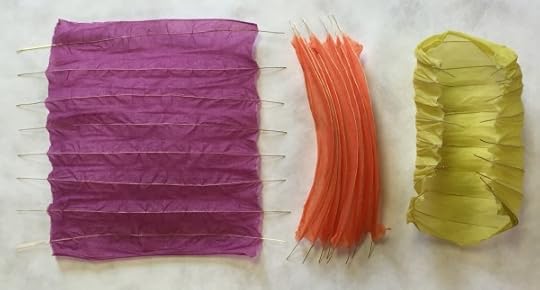
When I learned that I could embed items between two sheets of wet handmade paper during the papermaking process an entire new world opened up for me. I am perpetually interested in how I can use the papermaking process to create unique papers, how I can use innovative papermaking techniques to make my art and how I can simplify production processes.
Here you see three sheets of handmade abaca paper with 18 gauge brass wire embedded (I’ve also used 18 gauge copper and 20 gauge stainless steel, all chosen because they don’t rust). Here’s the cool thing about this wire paper: it makes a new material – you can bend it and the wire and paper hold their shape. The orange sheet shows how the sheets look after air drying. The purple sheet has been carefully stretched out and flattened, and the yellow/green sheet has been shaped, just to give you a hint of the possibilities. I have used this technique to create lamps and lanterns of varying shapes. The translucency of the fiber makes it a natural for illumination.
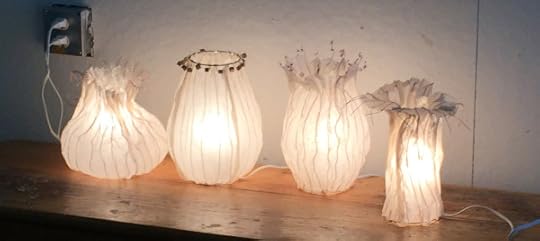
Student lamps made at a workshop at Oregon College of Art & Craft this past summer
————————————————————————————————————––––––––––––
In the Studio:
Here’s a studio tip from Linda Draper of San Antonio who came up with this unique way to make handmade paper envelopes.
Linda made a shaped deckle from children’s fun foam. She “drew” the yellow lines with fabric paint onto a piece of fiberglass window screen that she ultimately cut down to the outside dimension of her mould. To make paper, the fiberglass is placed on top of the mould, the fun foam on top of that and finally the wooden deckle. Linda suggests using a fairly thin concentration of pulp in the vat, and once the water is drained after pulling a sheet, she removes the wooden deckle and the foam deckle and carefully couches the sheet onto a felt. Those yellow lines protrude into the sheets of paper as they are being formed, making the paper thinner in those areas and therefore easy to fold and assemble the envelopes once they are dry.
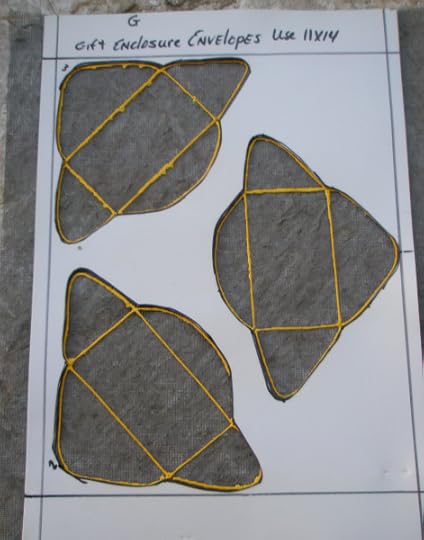
I’d love to feature other studio tips in The Sunday Paper. Leave a comment if you have something you’d like to share!
————————————————————————————————————––––––––––––
This video features Sentient Matrix, a recent work by Sara Garden Armstrong. The sculpture is an abstraction of the central nervous system and an exploration and translation of scientific information into art. Within translucent abaca forms, moving lights suggest the linear rhythms of nerve impulses. When the light stops, it represents what happens in multiple sclerosis (MS) when the myelin and nerve are damaged. This is a permanent installation at The National Multiple Sclerosis Society, Alabama-Mississippi Chapter Legacy of Leadership honoring M. Miller Gorrie.
Sara and I co-wrote an article about our recent installations that is in featured in the current issue of Hand Papermaking Magazine
Animal Tales is an exhibition at The British Library until 1 November. The exhibition celebrates the role of animals in literature with some historic books, beautiful illustrations and some unusual ones like this one featuring Dolly the Sheep and her clones.
Multiple cut-outs of the cloned sheep Dolly are included in this limited edition book that features the original article about the cloning in the journal Nature. Copyright Karen Bleitz
The artist Li Hongbo outdoes himself! Check out this installation at SCAD Museum of Art and try to envision what the shapes represent before you read the title. Amazing, right?! Scroll down to the bottom of the link to see them before they were unfolded into these forms.
li hongbo: Irons for the Ages, Flowers for the Day at SCAD Museum of Art until 1/24/2016
This is a great blog post by Cathryn Miller (byopiapress) about her decision to nail a book to a tree. There’s a great backstory with reference to other outdoor book projects that you’ll enjoy reading about. And the story about her book has the perfect ending! After twenty months of waiting, Cathryn got exactly the result she had hoped for: bald-faced hornets are turning the book into something useful. About 12 meters (40 feet) from the book, in a cluster of small branches, they are building a nest. Take a look!
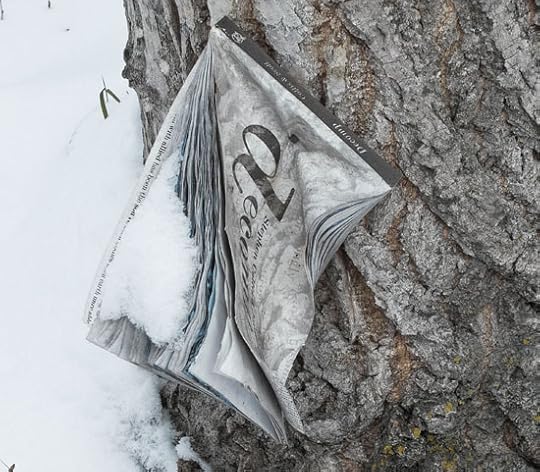 Check out this lovely video about Kelly Anderson, a young artist, designer and tinkerer who has done some incredible projects with paper, both in the physical and in the virtual world.
Check out this lovely video about Kelly Anderson, a young artist, designer and tinkerer who has done some incredible projects with paper, both in the physical and in the virtual world.
————————————————————————————————————––––––––––––
 If you enjoyed reading The Sunday Paper today, why not sign up to get it delivered to your in-box each and every Sunday? Click here to subscribe (it’s free), and you’ll receive my nifty pop-up alphabet template as a thank you gift!
If you enjoyed reading The Sunday Paper today, why not sign up to get it delivered to your in-box each and every Sunday? Click here to subscribe (it’s free), and you’ll receive my nifty pop-up alphabet template as a thank you gift!
If you read this blog regularly, would you consider making a donation to support the research, writing, design and delivery of The Sunday Paper? Click on that cute paper button (I made that paper) to see how you can provide support.
And if you run a paper-related business, you might be interested in promoting your business in The Sunday Paper.
Thank you to those who have pledged your support, and enjoy your Sunday!

